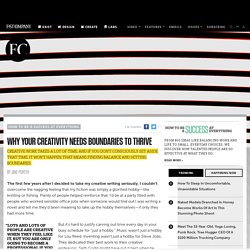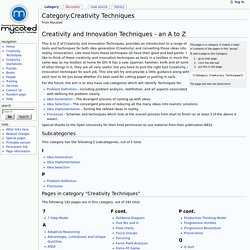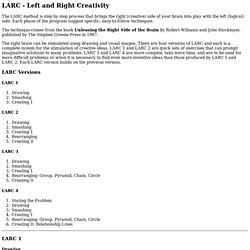

Train Your Brain To Let Go Of Habits – 10 Methods For Creating New Neural Pathways. When you understand how neural pathways are created in the brain, you get a front row seat for truly comprehending how to let go of habits.

Neural pathways are like superhighways of nerve cells that transmit messages. Why We're More Creative When We're Tired and 9 Other Surprising Facts About How Our Brains Work. 12.6K Flares Filament.io 12.6K Flares × One of the things that surprises me time and time again is how we think our brains work and how they actually do.

On many occasions I find myself convinced that there is a certain way to do things, only to find out that actually that’s the complete wrong way to think about it. For example, I always found it fairly understandable that we can multitask. Well, according to the latest research studies, it’s literally impossible for our brains to handle 2 tasks at the same time. 7 Deadly Sins of Creativity. Email Creativity is not just for artists and poets.

Everybody has the potential to exercise their creative mind – to innovate new ways of accomplishing things that will ultimately make life easier and more gratifying. Creativity magnifies the effectiveness of our natural talents, generating elevated levels of success and happiness by helping us discover more efficient ways to do what we love to do. Happiness is not in the mere possession of money; it lies in the joy of achievement, in the thrill of creative effort. - Franklin D. Roosevelt. Why Your Creativity Needs Boundaries to Thrive. The first few years after I decided to take my creative writing seriously, I couldn't overcome the nagging feeling that my fiction was simply a glorified hobby—like knitting or fishing.

Plenty of people helped reinforce that. I'd be at a party filled with people who worked sensible office jobs when someone would find out I was writing a novel and tell me they'd been meaning to take up the hobby themselves—if only they had more time. #5 The Four Most Powerful Types of Creative Thinking. Considering I’m a creative coach, some people are surprised to learn I’m a little sceptical about creative thinking techniques.

For one thing, there’s a lot more to creativity than thinking. It’s possible to sit around having lots of creative thoughts, but without actually making anything of them. Category:Creativity Techniques. This A to Z of Creativity and Innovation Techniques, provides an introduction to a range of tools and techniques for both idea generation (Creativity) and converting those ideas into reality (Innovation).

Like most tools these techniques all have their good and bad points. How Thinking in Reverse Can Make You More Creative. I already wrote in a previous blog post about being more creative by doing things the other way around.

Instead of doing things in the regular, logical, straightforward fashion, you get a fresh perspective and generate new ideas by doing the opposite of what would normally be expected. I recently came across three great examples of this, and I wanted to share them with you. The three examples are the following: Creative Thinking. Untitled Document. Untitled Document. Fuzzy Thinking. Western thinking is based on Aristotle ... around 2000 years old.

Unconscious Problem Solving. This method relies on the unconscious mind to be continually processing the various sensory inputs stored in short-term and long-term memory.

Using your unconscious to solve problems is a process of listening and a readiness to record ideas as they percolate into your conscious mind. Some of the greatest thinkers were great relaxers. Einstein was a daydreamer and spent much of his relaxation time sailing on a lake. LARC. The LARC method is step by step process that brings the right (creative) side of your brain into play with the left (logical) side.

Each phase of the program suggest specific, easy-to-follow techniques. The technique comes from the book Unleasing the Right Side of the Brain by Robert Williams and John Stockmyer, published by The Stephen Greene Press in 1987. The right brain can be stimulated using drawing and visual images. DO IT. This technique is fully described in the book The Art of Creative Thinking by Robert W. Olson and published by Perennial Library (ISBN 0-06-097051-0) 1980. The name is based on the following abbreviation: Define. Assumption Smashing. Neuro-Linguistic Programming. NLP Techniques Practitioners of Neuro-Linguistic Programming (NLP), a.k.a. the "science of subjective experience", have produced a number of techniques that can be used to describe the strategies used by highly effective people. Essentially, experts are carefully studied and analyzed (or modeled in NLP parlance) as a way to make conscious and unpack the mental strategies they used to get expert results.
Once the strategies are decoded, they are the available for others to enhance their own expertise. Ideatoons. From "Thinkertoys" by Michael Michalko - Published by Ten Speed Press (c) 1991 "Therefore, when I have won a victory I do not repeat my tactics but rearrange them to circumstances in an infinite variety of ways. - Sun Tzu: The Art of War We think in different ways and two complementary modes are visual thinking and verbal thinking. The method liberates your thinking from the world of words by utilising the power of patterns, shapes and pictures. Pattern language is a visual thinking technique, and its visual, flexible nature makes it a useful creative device for seeing new and different relationships between attributes. Drawing and Visual Thinking. In the Realm of the Senses. This technique focuses on the five senses as an area of focus, attribute listing or idea prompter.
I took the name from a film by Nagisa Oshima, and it evokes the idea of each sense evoking different sets of responses. Think about various experiences you have had, such as hiking, running, dining out, falling in love and doing your job. Lotus Blossom. Metaphorical thinking. Synectics. The term Synectics from the Greek word synectikos which means "bringing forth together" or "bringing different things into unified connection. " Since creativity involves the coordination of things into new structures, every creative thought or action draws on synectic thinking. Story-boarding. Storyboards go back to the very beginnings of cinema, with Sergei Eisenstein using the technique. Mind Maps and Mind Mapping. The human brain is very different from a computer. Whereas a computer works in a linear fashion, the brain works associatively as well as linearly - comparing, integrating and synthesizing as it goes.Association plays a dominant role in nearly every mental function, and words themselves are no exception.
Every single word, and idea has numerous links attaching it to other ideas and concepts. Imitation. How many ideas are really original? It is quite valid to imitate other ideas as a preparatory step to original thinking. Morphological Forced Connections. Attribute Listing. Notes from "Creating Workforce Innovation" by Michael Morgan - published by Business and Professional Pubolshing 1993. Forced Analogy. Forced analogy is a very useful and fun-filled method of generating ideas. The idea is to compare the problem with something else that has little or nothing in common and gaining new insights as a result.
Brainstorming. The term Brainstorming has become a commonly used word in the English language as a generic term for creative thinking. Checklists. The Discontinuity Principle. Six Thinking Hats. Lateral Thinking. Summary of questions from "Applied Imagination" Ask Questions. Problem Reversal. Random Input Technique.